#swahili influence
Text
Kanti Ambertales
Full Name: Kantauna-Akila Ambertale
Nickname(s): Kanti, Kili
Meaning:
Kantauna - Daughter of Beauty
Akila - Intelligent
Pronoun(s): She/Her/They/Them
Gender: Feminine
Sexuality: Sapphic
---
Height: 6’3
Weight: 185 lbs
Age: 23
Class: Druid (Grassland)
Alignment: Neutral Good
---
Ethnicity: Western
Eye Color: Golden Orange
Fur Color: Predominantly black - legs and arms are white and she’s speckled with orange. She has white flecks across her face like freckles and a blaze on her forehead.
Mane Color: It’s completely black
Mane Style: Short on her neck but deliberately grown out on her forehead. She keeps it short enough to not fall into her eyes but long enough to properly shape it. The entire mane into neat and pretty dreads and the base of each have small, embroidered golden bands.
Appearance: A tall and muscularly athletic woman with a smaller chest and a medium-sized tail with a long furred tail. Her hips and shoulder are distinctly marked, her white splotches look like stylized suns and. Her tail is usually swinging slowly in her constant thought.
Appearance (Clothes): Clothes wise when she’s around friends or just roaming the world, Kanti usually wears short-shorts and various long sleeved but think shirts. Beneath these she usually has a crop top for when it gets hot. Her family wears traditional clothes she wears caped rompers - predominantly a burnt orange with sky blue patterns stretched across it like tree branches. She wears a red sash that pins at her hip with a blue pin shaped like two wild dogs cuddled around each other.
---
Dam: Jaha - a refined, respected and beloved woman, Jaha is the head of the west Ambertale noble houses. She loves all of her children dearly though because of her busy schedule, she doesn’t have as much time for them as she’d like. She was devastated and heartbroken when her eldest daughter was forced to accept a vampire bite to save herself and was even more upset when Matriarch Busara revoked her daughter’s position. She knows she doesn’t spend as much time with her youngest as she should and tries to make up for it with gifts and little notes.
Sire: Tamu - a naturally boisterous and excitable man, Tamu is content with his place in life. Some might grow envious or resentful of never being able to move up the ranks quite as far or as fast as the women in his family but Tamu prefers being down in the ranks. It’s much less pressure and unlike his wife, he has time to spend with his children. Lately he’s spent his every free moment praying desperately to Sayin for life og his youngest daughter.
Sibling(s):
Onyesha - Kanti’s eldest sister and the one initially entrusted with the position of matriarch. Even though Onyesha was never particularly kind to her, Kanti loves her elder sister and considers it a grace injustice that she was removed from her position. Some part of her is convinced that Matriarch Busara made a hasty decision in removing Onyesha from her position and is privately convinced that she’s only warming the seat and it doesn’t belong to her.
Kuende - Kanti’s eldest brother and is betrothed to a noble from another house. Kanti barely knows Kuende, her brother having moved to the bachelor’s house two years before she was born and only left it once Kanti was moved into the bachelorette’s house. The few times she encountered him, he didn’t seem to upset or bothered by her presence and she doesn’t mind his.
Sultan - Kanti’s little brother and the most promising noble guard that ever come from her house. Kanti is very proud of her little brother for living up to the ancient beliefs that the youngest son will the most powerful but she doesn’t appreciate his attitude. Though Sultan is perfectly pleasant to her - a real excitable baby brother - he’s very dismissive of the common folk. She dearly hopes that eventually Sultan realizes that all of Ambertown bleeds when cut.
Panya - A terrible tragedy, Panya is Kanti’s eight-year-old little sister who is deeply sick. No one is sure what happened to her - she explored the farms one day and returned seemingly fine. Two days later, Kanti was rushing her to the healer’s wing in tears as Panya had collapsed. A large part of the reason that Kanti accepted becoming Matriarch is that apprentices (Basiti) are supposed to go on pilgrimages and come back with either a life-changing story or something phenomenal.
Friend(s): N/A
Pet/Companion(s): An eager volunteer for caring for the noble animals, Kanti has a closer relationship with most of the beasts of Ambertale than her family. Despite this, she does have a few favorites that she considers her friends.
Kanene - A tambourine dove who is particularly affectionate. Kanti was actually there the day that Kanene hatched, finding her egg on the ground likely abandoned by a fleeing egg predator. Kanti raised the hatchling from hatching spending many exhausted days creating special food for the hatchling and training it. Kanene is seen as Kanti’s personal messenger bird by this point.
Kamara - A sooty falcon who is very motherly towards Kanti. She’s not quite sure why - for all intent and purposes, the falcon landed on her wrist after she released a different one for training and began preening her hair. Kanti just shrugged it off and began bringing her prey and performed falconry activities. Kamara is technically a wild falcon but her affection towards Kanti has made her a common face.
---
Deities (Yora):
Oiya - Goddess of wind, lightning, fire and magic
Yemoja - Patron goddess of women, maternity and the west river
Obatala - God of the mortal plane, created all the “Original
People”
Sayin - God of healing, illnesses and herbs
---
Spirits (Daya):
Akintoye (Golden Tiger) - A benevolent spirit and one of two spirits that Kanti can hear without divining. Akintoye is aggressively supportive and tries to show Kanti the love and affection that she struggles to receive from her parents in the shadows of her elder siblings. She can be gentle and often is when consoling Kanti from her nightmares about the fate of her sister. Kanti personally believes that Akintoye is the older sister she’d heard so much about but died before she was born.
Siwazuri (Cape Buffalo) - A mischievous negative spirit that constantly whispers rude or cruel things into Kanti’s ears. Frequently in her lowest moments, Siwazuri whispers her faults and failings, exaggerating them and get distorting Kanti’s view of herself. Siwazuri is constantly at war with Akintoye in their desire to influence Kanti. He’s always willing to get involved in a fight and at times, will harass Kanti into joining or starting fights she’s uncomfortable with.
---
Background (Noble):
Champion of the People: Born to a tertiary family, Kanti spent more time associating with the commoners of her town rather than the rest of the noble families. The people recognized her lower position but also realized that she was a bleeding heart - Kanti quickly found herself as a messenger to the people, informing her fellow noble born of the needs of their people. Among the commoners, she’s a hero and among the noble born, she gathers information faster than some appointed overseers.
Well Intentioned Disgrace: No matter what Kanti attempts to do, she always seems to embarrass herself and her family. No one’s particularly cruel but she’s definitely treated as an embarrassment to be hidden away from outsiders. Kant is torn between humiliation at being frantically shooed off and relieved at being allowed to escape most of the pomp, circus and ceremony associated with noble life.
Controversial Heiress: Due to the actions of her eldest and completely disgraced sister, Kanti has noticed that the Matriarch has begun training her as a primary heiress. This worries her - as a tertiary family daughter, she’d assumed that the most she’d have to look forward to is being a tether, hence the reason she spent so much time getting to know the people she’d be interacting with.
Her fears were confirmed and when she was 16, the Matriarch Busara announced that she was being officially moved into the main family as the primary heiress. Many of those she considered her friends grew cold and distant to her and now, Kanti spends most of her day hiding from her family among the common folk. Despite her fear, Kanti wants to do what’s right for her family and the people so she attends all of her lessons dutifully.
#projects by ankh#worldbuilding#kanti ambertale#dnd#dnd homebrew#dnd character#dnd races#lore#magic#painted furniture#yoruba influence#swahili influence#swahili names#tamil influence
0 notes
Text
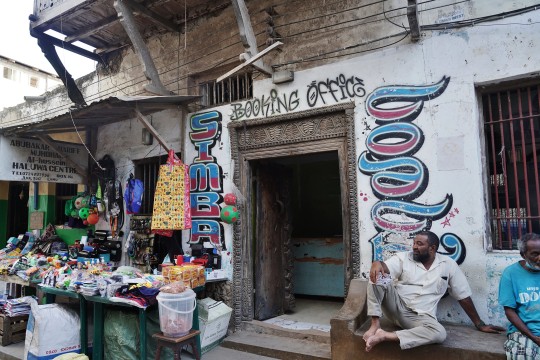
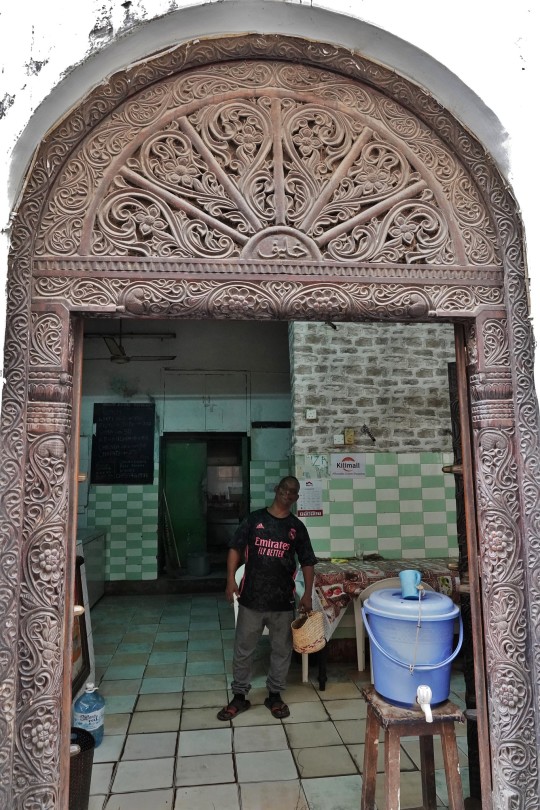
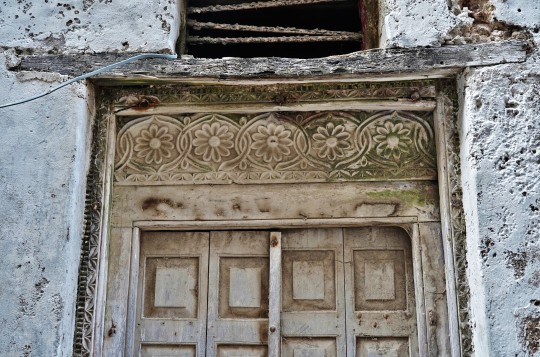

the old town on lamu island in kenya is one of the oldest and best-preserved swahili settlements in east africa, having been founded in the 14th century, and - unlike many other swahili settlements - continuously inhabited since. historically, it served as an economic powerhouse, and today still lives as a cultural one. like swahili culture itself, its buildings mix architectural elements from cultures who've come in contact with the area, including bantu, arab, persian, indian, and european.
one of the most distinctive features of the old town's architecture - and swahili architecture in general - is the carved detailing on doors, which is usually done on wood. since carved doors were once considered a sign of wealth, many buildings in lamu old town have them. the patterns are often geometric and nature-inspired and sometimes contain religious inscriptions.
#swahili coast#details#my posts#was gonna just post about one place but i am in love with these doors#most of the swahili settlements which were abandoned/ruined were because of various colonial threats btw#which went on for a very /very/ long time#influence in art can be pretty but it doesn't always come positively. that's history for you
18 notes
·
View notes
Video
youtube
DJ LYTA - MAHABA BONGO MIX 2023 | zuchu,alikiba,harmonize,jay melody @certifiedhomesltd7871
#youtube#Cerified East Africa#soft Music#Swahili Melodies#Love Melodies#DJ LYTA#MAHABA BONGO MIX 2023#zuchu#alikiba#harmonize#jay melody#music#melody#Zuchu & Diamond Platinum#Tanzania#Zanzibar#and more#Swahili#indian influences
17 notes
·
View notes
Text
Title: "The Significance and Diversity of African Names"
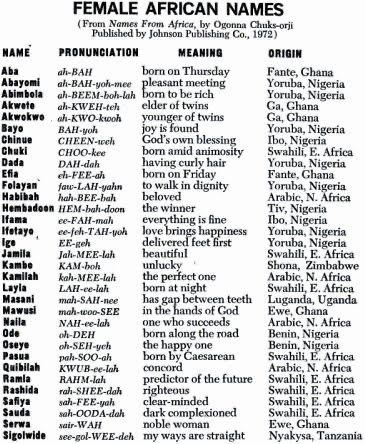
Introduction
African names are a reflection of the continent's incredible diversity, culture, history, and traditions. With over 2,000 distinct languages spoken and a multitude of ethnic groups, Africa is a treasure trove of names that carry deep meanings and unique stories. In this article, we'll explore the rich tapestry of African names, their significance, and the cultural diversity they represent.
The Importance of Names
Names hold a special place in African societies. They are more than mere labels; they encapsulate a person's identity, heritage, and often convey messages of hope, aspiration, and blessings. African names are deeply rooted in the belief that a name can shape a person's destiny and character.
Linguistic Diversity
Africa's linguistic diversity is astounding, with thousands of languages spoken across the continent. Each language group has its distinct naming traditions, resulting in a vast array of names. For example, in West Africa, Akan names such as "Kwame" (born on a Saturday) and "Kofi" (born on a Friday) are common, while in East Africa, Swahili names like "Amina" (trustworthy) and "Nia" (purpose) are prevalent.
Meanings and Symbolism
African names are rich in meaning and symbolism, often reflecting the circumstances of a child's birth, their family history, or the aspirations of their parents. Names can signify virtues like courage, strength, and wisdom or convey hopes for a prosperous and fulfilling life.
Family and Heritage
In many African cultures, names are chosen to honor ancestors, celebrate cultural heritage, or connect the child to their roots. This practice ensures that generations remain connected to their family's history and traditions. For example, the Igbo people of Nigeria often use "Ngozi" (blessing) to convey the hope for a blessed life..
Naming Ceremonies
Naming ceremonies are significant events in many African communities. These ceremonies are joyous occasions where family and friends gather to celebrate the birth of a child and bestow a name. The rituals and customs associated with these ceremonies vary widely, showcasing the diversity of African naming traditions.
Modern Influences
In today's globalized world, African names are not confined to the continent. Many people of African descent living outside Africa proudly bear African names, celebrating their cultural heritage and contributing to the global recognition of the beauty and significance of these names.
Conclusion
African names are a testament to the continent's diversity, culture, and history. They carry profound meanings, connect individuals to their heritage, and celebrate virtues and aspirations. As we embrace and appreciate the beauty of African names, we also acknowledge the importance of preserving and passing on these cultural treasures to future generations, ensuring that the rich tapestry of African identity remains vibrant and thriving.
1. **Kwame (Akan, Ghana):** A male name meaning "born on a Saturday."
2. **Ngozi (Igbo, Nigeria):** A unisex name meaning "blessing" or "good fortune."
3. **Lulendo (Lingala, Congo):** A male name meaning "patient" or "tolerant."
4. **Amina (Swahili, East Africa):** A female name meaning "trustworthy" or "faithful."
5. **Kwesi (Akan, Ghana):** A male name meaning "born on a Sunday."
6. **Nia (Swahili, East Africa):** A unisex name meaning "purpose" or "intention."
7. **Chinwe (Igbo, Nigeria):** A female name meaning "God owns" or "God's own."
8. **Mandla (Zulu, South Africa):** A male name meaning "strength" or "power."
9. **Fatoumata (Wolof, Senegal):** A female name meaning "the great woman."
10. **Kofi (Akan, Ghana):** A male name meaning "born on a Friday."
These are just a few examples, and there are countless other African names with unique meanings and significance. It's essential to remember that Africa is incredibly diverse, and each region and ethnic group has its own naming traditions and languages, contributing to the rich tapestry of African names.
The most popular African names among Black Americans can vary widely based on individual preferences, family traditions, and regional influences. Many Black Americans choose names that connect them to their African heritage and celebrate their cultural roots. Here are a few African names that have been embraced by some Black Americans:
1. **Malik:** This name has Arabic and African origins and means "king" or "ruler."
2. **Amina:** A name of Swahili origin, meaning "trustworthy" or "faithful."
3. **Kwame:** Derived from Akan culture, it means "born on a Saturday."
4. **Nia:** A Swahili name representing "purpose" or "intention."
5. **Imani:** Of Swahili origin, it means "faith" or "belief."
6. **Jamal:** This name has Arabic and African roots and means "handsome."
7. **Ade:** A Yoruba name meaning "crown" or "royalty."
8. **Zuri:** Of Swahili origin, it means "beautiful."
9. **Sekou:** Derived from West African languages, it means "fighter" or "warrior."
10. **Nala:** This name is of African origin and means "gift."
It's important to note that while these names have African origins, their popularity among Black Americans can vary by region and individual choice. Additionally, some Black Americans choose to create unique or hybrid names that blend African and American influences, reflecting their personal and cultural identities. The naming choices among Black Americans are diverse and reflect the rich tapestry of their heritage and experiences.
African Languages: A Tapestry of Diversity and Culture"
Introduction
Africa is a continent known for its stunning natural landscapes, diverse wildlife, and rich cultural heritage. Among its many treasures, the continent boasts an astonishing linguistic diversity that is often overlooked. In this article, we delve into the fascinating world of African languages, exploring their diversity, cultural significance, and the challenges they face in a rapidly changing world.
The Linguistic Kaleidoscope
Africa is home to over 2,000 distinct languages, making it one of the most linguistically diverse regions on the planet. These languages belong to several different language families, including Afroasiatic, Nilo-Saharan, Niger-Congo, and Khoisan, each with its unique characteristics.
Niger-Congo Family: The vast majority of African languages, including Swahili, Yoruba, Zulu, and Kikuyu, belong to the Niger-Congo language family. This family stretches across West, Central, and Southern Africa, reflecting the continent's linguistic richness.
Afroasiatic Languages: Arabic, a member of the Afroasiatic family, has a significant presence in North Africa, while other Afroasiatic languages like Amharic are spoken in the Horn of Africa.
Nilo-Saharan Languages: Found in parts of East and North Central Africa, Nilo-Saharan languages include Dinka, Kanuri, and Nubian.
Khoisan Languages: These languages, characterized by their unique click consonants, are primarily spoken by indigenous groups in Southern Africa, such as the San and Khoi people.
Cultural Significance
African languages are not just tools of communication; they are repositories of cultural heritage and identity. They carry the history, stories, and traditions of their speakers. Each language is a key to unlocking the rich tapestry of African cultures, from oral storytelling and folklore to religious rituals and traditional medicine
Preserving Cultural Diversity
Despite their cultural importance, many African languages are endangered. The rise of global languages like English, French, and Portuguese, often due to colonial legacies, has led to the decline of indigenous languages. To address this, efforts are being made to document, preserve, and revitalize endangered African languages through education, community initiatives, and technology.
A Language of Unity
In some regions, African languages are a means of fostering unity. For example, Swahili, a Bantu language with Arabic influences, serves as a lingua franca in East Africa, promoting communication and cooperation among diverse ethnic groups.
Challenges and Opportunities
While African languages face challenges in an increasingly interconnected world, they also offer unique opportunities. Embracing linguistic diversity can strengthen cultural identities, promote inclusive education, and drive economic growth through multilingualism.
Conclusion
African languages are an integral part of the continent's rich heritage and cultural tapestry. They represent the diversity of Africa's peoples and their traditions. While challenges exist, there is hope that efforts to preserve and celebrate these languages will ensure that they continue to thrive, enriching the world with their unique beauty and significance. In an increasingly globalized world, Africa's linguistic diversity is a testament to the resilience and vibrancy of its cultures.

#life#animals#culture#aesthetic#black history#history#blm blacklivesmatter#anime and manga#architecture#black community#language
709 notes
·
View notes
Text
also realizing just how much in common swahili east africa (particularly kenya due to shared british colonialism but still valid across the entire swahili-speaking region) has with malaysia and how even visually our architecture and climate is so so so similar due to overlapping influences from the same cultures - arab, indian, chinese, portuguese, and british (in the case of tanzania and mozambique it's the french) like i was watching some documentaries for school and i swear to god even just visually the cities of mombasa and zanzibar and antananarivo etc felt so incredibly familiar to me they look so much like malacca and penang and kl i was in awe... the tropical maritime climate too, the coral concrete everywhere covered in green damp and moss and the red earth and the food too everything about it all felt so familiar just like home. the multiethnic society with a complex web of ethnicities and languages from all over asia and africa... i felt/feel such kinship so strongly i feel dizzy
#also knowing that kenya has the highest pop of sikhs in africa#much like how malaysia has the highest pop of sikhs in asia outside of india-pakistan#and that kenyan sikhs were brought there by the british in much the same conditions my people were to malaya
43 notes
·
View notes
Text
The Fascinating Impact of Islamic Trade Expansion
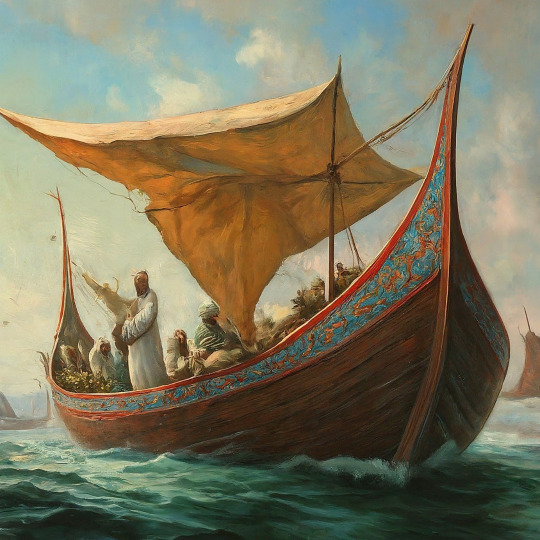
In the rich legacy of Islam, trade emerges as a vibrant thread, stitching together diverse cultures and societies. The profound impact of Islamic trade on the spread of Islam, and its transformative influence in regions such as East Africa and Indonesia. Through engaging insights, we uncover the beauty of Islam as a unifying force that transcends borders and fosters connections among people.
Trade Routes as Pathways of Faith
Islamic trade flourished along the ancient Silk Road, acting as a conduit not only for goods but also for the exchange of ideas and beliefs. The Quran emphasises the importance of knowledge and learning, encouraging the pursuit of wisdom through interactions with different cultures.
O humanity! Indeed, We created you from a male and a female, and made you into peoples and tribes so that you may ˹get to˺ know one another. Surely the most noble of you in the sight of Allah is the most righteous among you. Allah is truly All-Knowing, All-Aware. Quran 49:13
Prophet Muhammad’s teachings promote fair and ethical trade practices, emphasising honesty and transparency in all transactions. These principles laid the foundation for a positive image of Muslims in the trading world.
‘Deal not unjustly, and you shall not be dealt with unjustly.’ (2:279)
‘God loves those who are fair and just.’ (49:9)
‘A truthful and trustworthy merchant will be in the company of the Prophets, the upright and the martyrs.’ (reported by Tirmidhi)
East Africa: Islamic Trade and Cultural Fusion
Islamic trade played a pivotal role in the cultural and religious fusion along the Swahili Coast creating a melting pot of cultural influences. The exchange of goods was accompanied by the exchange of ideas, leading to the flourishing of Islam in East Africa.
Muslim traders in East Africa became integral members of local communities, contributing to the socio-economic development of the region and making it one of the wealthiest regions in the world at the time. This interaction exemplified Islam’s emphasis on community and mutual support.
The maritime routes of the Indonesian archipelago served as conduits for Islamic traders, bringing not only spices but also the teachings of Islam. The Quran encourages exploration and appreciation of the diverse creations of Allah.
We will show them Our signs in the universe and within themselves until it becomes clear to them that this ˹Quran˺ is the truth. Is it not enough that your Lord is a Witness over all things? Quran 41:53
Islam took root in Indonesia, fostering unity amidst the diverse cultures of the archipelago. The Quran celebrates diversity of cultures and people, recognising it as a divine manifestation resulting in the spread of Islam to a plethora of different cultures worldwide, making a religion that started among the Arabs become a religion where only 20% of the Muslim population are Arab.
The beauty of Islam unfolds through its impact on trade, acting as a catalyst for cultural exchange, knowledge dissemination, and exchange among diverse communities. As we reflect on the historical journeys of Islamic traders, let’s appreciate the way Islam’s principles of fairness, honesty, and community building have left an indelible mark on the regions they touched.
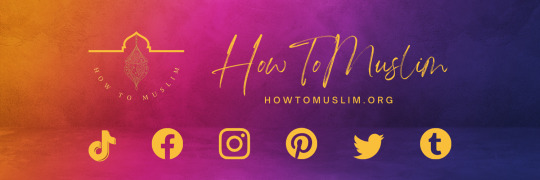
References:
Quran 49:13
Quran 96:1–5
“Islam in East Africa.” BBC Religions, www.bbc.co.uk.
#islamdaily#muslim#allah#quran#islamic#islamiyet#islamicreminders#islam#mosque#new article#new blog#newblog#trade#history#culture#human history
30 notes
·
View notes
Text
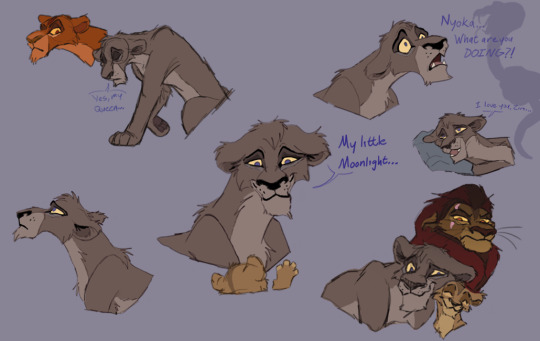
TLK: Nandi
After drawing sketches of Bianka, I felt like paying a revisit to a character I drew only one other time: Nandi. She is my fanmade mother of Zira, and mate of Nyoka (AKA the Strange Lion). Her name has many meanings in many languages. For starters, it can mean "with me" in Swahili, it's also part of the Swahili word for "nice" (full word is "Kamnandi"), it also means "sweet" or even "here I am" in Zulu, and "joy" or "happiness" in Sanskrit. All words are appropriate for her, as I've come to find out.
Nandi was not native to the Pridelands. She began her life in Pride Rock as a shy advisor to Uru. Nandi was very unlike her ruler, as she was unconfident, meek, and soft-spoken. Uru naturally possessed an intimidatingly elegant streak, but cordially encouraged Nandi with advice in order to help with her self-worth.
Nandi joined the Pridelands after the banishment of Nyoka. Her naïveté of his story is what allowed her to meet with him in secret at the Outlands with hardly a problem. Nandi was charmed by Nyoka, and was eager to have a child with him. He eventually warmed up to the idea, but internally swore not to raise the cub like a cub, but an extension of him, with the idea of integrating her into the pride to slowly take over the kingdom that once belonged to his ancestors.
They both agreed on the name "Zira" for different reasons: Where Nyoka was from, it was a word meaning "hate", where Nandi was from, it meant "moonlight", which had been perfect for a cub born at night.
Later on in her life as a Pridelander, Nandi, along with Uru, partook in mentoring the next generation of huntresses, including her daughter Zira, her classmate Sarafina, and Uru's top student, Sarabi.
However, after Nandi and Nyoka's separation relationship-wise, Zira's hunting lesson schedule would often be interrupted by Nyoka's harsh training in the Outlands. Zira took on a zealous, fiery, conflicted personality, and her hunting skills had also been affected as she would show mercilessness with prey. Nandi noticed Zira's harsh hunting strategies, bottled-up emotions, and cuts and bruises when she would return from the Outlands.
Nandi finally put her paw down, and firmly demanded that Zira cease her isolated visits with her father. This had unfortunate outcomes: Zira, as Nyoka's teachings successfully corrupted her, had turned on her mother, fully believing her mother was only slowing her growth and dragging her down. After a rendezvous with Nyoka at the Outlands, while their daughter was away, her mate threatened her using his cobra friend, Kuuma, to keep her in line and out of his and Zira's business.
Feeling threatened that Nandi would tell the Pridelanders of his threats, Nyoka sent Kuuma to deliver small doses of venom in bites he would inflict on Nandi in her sleep. Zira saw Nandi's mind decline over time the last few times she ever visited her, and Nyoka would tell Zira that Nandi had been becoming too unfit to be an influence on her. Zira grew into adulthood trying to understand which parent had been in the wrong, as Nyoka would emotionally neglect her, but she truly believed his mischaracterizing words about Nandi.
Kuuma's venom didn't directly kill Nandi, but she did eventually pass before the events of the films from possible complications.
Her granddaughter Vitani greatly resembles her, sporting square features, a head tuft, dark periwinkle eyes, and freckles above her mouth. Her grandson Nuka also resembles her, inheriting her lanky frame, ear tufts, and grayish-brown pelt. Their personalities parallel her too, such as poor self-worth and skittishness respectively.
25 notes
·
View notes
Text
Kabru's name
(I’ll provide some links in a reply, so Tumblr doesn’t eat this)
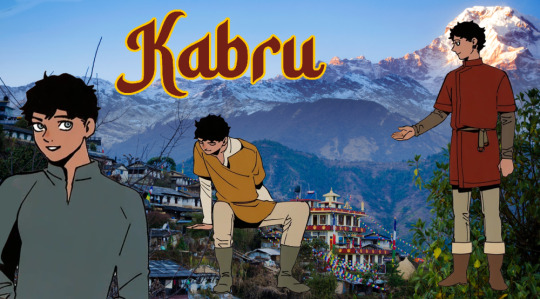
(UPDATE: Full version of this research is available here!)
Fun Dungeon Meshi facts! Kabru’s name is also the name of one of the peaks of the Himalayan mountain chain. It’s on the border between India and Nepal, which fits with Kabru’s skin and hair color (and texture). Also a lot of clothes and color choices Kui makes in the Daydream hour supplements really give me a Nepalese vibe, especially that red tunic. Lighter colored eyes are also not unheard of in that region, though obviously blue is still rare.
Utaya is also the name of a real place! It’s a small village (population of 98 people) at the foot of a mountain in the sub-arctic region in north-eastern Russia, and the name ‘Utaya’ is from the Yakut language, which has Turkic origins. Utaya also means ‘mandible’ in Swahili, and possibly is a name that means ‘Always bright’ in Hindi? Can’t confirm those last two.
Anyway all that to say that I HC Utaya having a culture influenced by Nepal and India, and I HC Kabru’s mom being named Annapurna, which is another mountain in the Himalayan range, named after the goddess of food - what could be more fitting for Dungeon Meshi, right?
I also HC Kabru having a big dick cuz he’s named after a mountain and quite popular with the ladies but that’s really not that important i just think it’s funny
Some pics of Nepalese and Indian men that reminded me of Kabru under the cut, along with some more general pictures of the people of Nepal. Enjoy and do what you will with the fruits of my research!
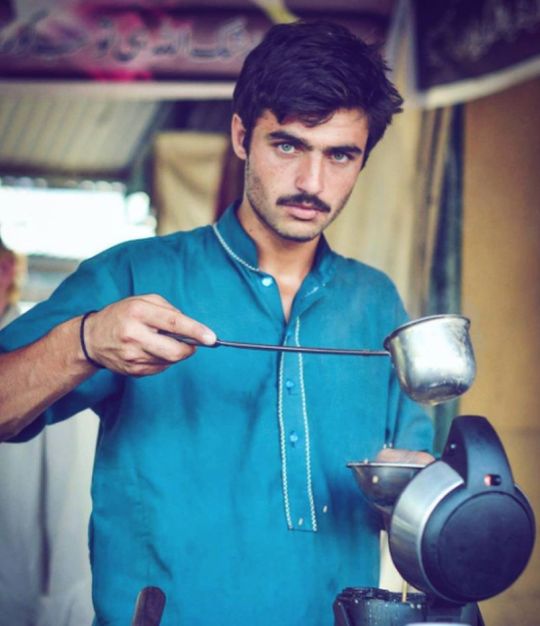
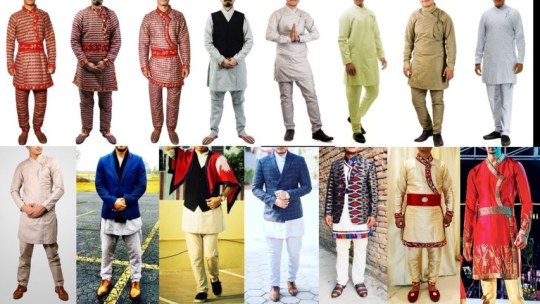

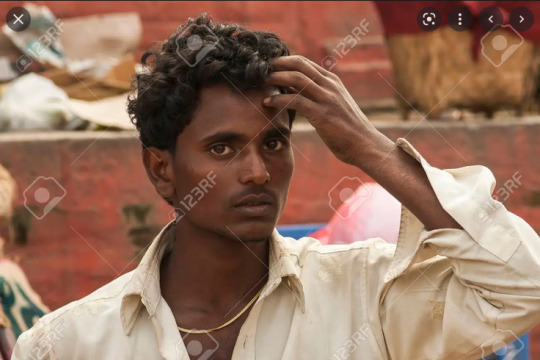
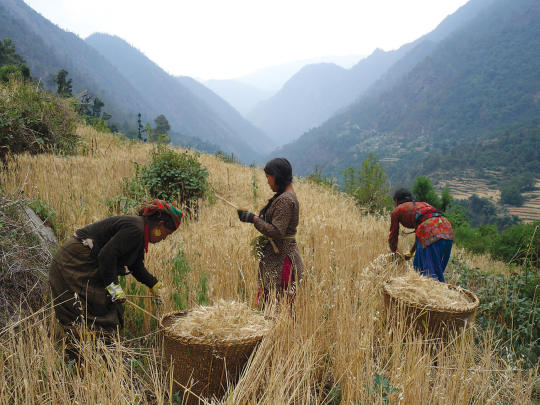

#dungeon meshi#delicious in dungeon#kabru#dunmeshi#ダンジョン飯#headcanons#my stuff#Dungeon Meshi Research
186 notes
·
View notes
Text
The Lion King (1994)

The Lion King is an animated Disney film released in 1994, directed by Roger Allers and Rob Minkoff. It tells the epic coming-of-age story of Simba, a young lion cub destined to become king of the Pride Lands, a vast African savanna. The film is set against the backdrop of a lush and vibrant landscape, rich with African-inspired imagery and culture.
In what ways does the film’s score situate the story with its narrative context?
Hans Zimmer's score for The Lion King plays a crucial role in situating the story within its narrative context. The use of African-inspired instrumentation, such as drums, flutes, and vocal chants, evokes the landscapes and cultures of the African savanna, where the story is set. This musical backdrop helps immerse the audience in the world of the film, enhancing the emotional impact of key moments and reinforcing the themes of family, identity, and the circle of life.
The presence of African languages, particularly Swahili and Zulu, plays a significant role in situating the context of the film within the African setting. Swahili, a widely spoken language in East Africa, including countries like Kenya, Tanzania, and Uganda, serves as a linguistic element that enhances the authenticity and cultural richness of the narrative. Zulu, a South Africna language, is present in the beginning of the classic song, "Circle of Life," provided by Lebo M., a South African composer.
youtube
2. How do songs use character performance to push cultural authenticity in the film's diegisis?
The songs in The Lion King not only advance the plot but also serve to deepen the film's cultural authenticity through character performance. For example, the character of Rafiki, voiced by Robert Guillaume, performs the song "Circle of Life" in a manner that draws from African musical traditions. Rafiki's energetic and spiritual rendition of the song reflects his role as a wise and mystical shaman within the Pride Lands, adding layers of cultural richness to the film's diegesis.
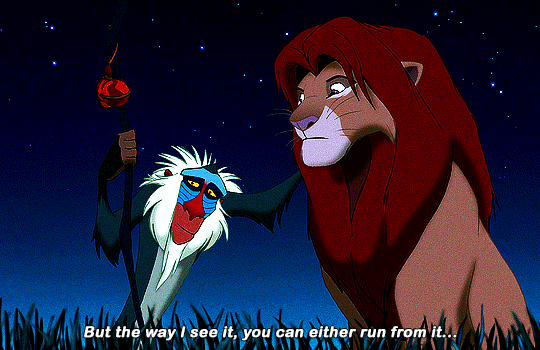
It's important to recognize the potential for misrepresentation, appropriation, and perpetuation of stereotypes. Robin Armstrong's exploration of musical colonization and appropriation in films like "Moana" provides a framework for understanding how colonialist perspectives can manifest in the portrayal of culture and identity in cinema.
One of the primary concerns with the colonialist lens is the tendency to exoticize or essentialize cultures that are depicted in film. In the case of The Lion King, while the film draws inspiration from African landscapes and cultures, there is a risk of reducing these diverse and complex traditions into simplistic or stereotypical portrayals. This can perpetuate harmful stereotypes and reinforce Western perspectives of Africa as a monolithic entity, rather than recognizing its diversity and richness.
Moreover, the colonialist lens may lead to the appropriation of cultural elements without proper understanding or respect for their significance. While the film's score and visual aesthetics draw from African musical traditions and imagery, there is a danger of these elements being co-opted for the purpose of entertainment without meaningful engagement with the cultures from which they originate.
3. In what ways does the film use musical “framing” to structure the score within familiarized styles?
The Lion King utilizes musical framing to structure its score within familiarized styles while incorporating African influences, creating a blend of familiarity and exoticism that appeals to a broad audience. This approach allows the film to maintain accessibility while still immersing viewers in the African setting and cultural context. Robin Armstrong's exploration of musical colonization and appropriation in films like "Moana" provides a lens through which to analyze how this framing functions within The Lion King.
One way in which the film employs musical framing is through the use of Broadway-inspired arrangements and melodies. Many of the songs in The Lion King, such as "I Just Can't Wait to Be King" and "Be Prepared," feature catchy tunes, dynamic orchestrations, and theatrical vocal performances characteristic of Broadway musicals. This familiarized style helps to engage viewers and draw them into the narrative, creating a sense of excitement and emotional resonance.
15 notes
·
View notes
Audio
Lingthusiasm Episode 76: Where language names come from and why they change
Language names come from many sources. Sometimes they’re related to a geographical feature or name of a group of people. Sometimes they’re related to the word for “talk” or “language” in the language itself; other times the name that outsiders call the language is completely different from the insider name. Sometimes they come from mistakes: a name that got mis-applied or even a pejorative description from a neighbouring group.
In this episode, your hosts Gretchen McCulloch and Lauren Gawne get enthusiastic about how languages are named! We talk about how naming a language makes it more legible to broader organizations like governments and academics, similar to how birth certificates and passports make humans legible to institutions. And like how individual people can change their names, sometimes groups of people decide to change the name that their language is known by, a process that in both cases can take a lot of paperwork.
Read the transcript here.
Announcements:
We’re doing another Lingthusiasm liveshow! February 18th (Canada) slash 19th (Australia)! (What time is that for me?) We'll be returning to one of our fan-favourite topics and answering your questions about language and gender with returning special guest Dr. Kirby Conrod! (See Kirby’s previous interview with us about the grammar of singular they.)
This liveshow is for Lingthusiam patrons and will take place on the Lingthusiasm Discord server. Become a patron before the event to ask us questions in advance or live-react in the text chat. This episode will also be available as an edited-for-legibility recording in your usual Patreon live feed if you prefer to listen at a later date. In the meantime: tell us about your favourite examples of gender in various languages and we might include them in the show!
In this month’s bonus episode we get enthusiastic about some of our favourite deleted bits from previous interviews that we didn't quite have space to share with you. Think of it as a special bonus edition DVD from the past two years of Lingthusiasm with director's commentary and deleted scenes from interviews with Kat Gupta, Lucy Maddox, and Randall Munroe.
Join us on Patreon now to get access to this and 70+ other bonus episodes, as well as access to the Lingthusiasm Discord server where you can chat with other language nerds, and get access to our upcoming liveshow!
Here are the links mentioned in the episode:
‘A grammatical overview of Yolmo (Tibeto-Burman)’ by Dr Lauren Gawne
‘Language naming in Indigenous Australia: a view from western Arnhem Land’ by Jill Vaughan, Ruth Singer, and Murray Garde
Wikipedia List of Creole Languages
Wikipedia entry for Métis/Michif
‘A note on the term “Bantu” as first used by W. H. I. Bleek’ by Raymond O. Silverstein
Lingthusiasm episode ‘How languages influence each other - Interview with Hannah Gibson on Swahili, Rangi, and Bantu languages’
Wikipedia entry for Endonym and Exonym
All Things Linguistic post on exonym naming practices in colonised North America
Tribal Nations Map of North America
Wikipedia entry for Maliseet
OED entry for ‘endoscope’
Wikipedia entry for Light Warlpiri
Language Hat entry for Light Warlpiri
Los Angeles Times article about the use of Diné instead of Navajo
OED entry for ‘slave’
Wikipedia entry for names of Germany
You can listen to this episode via Lingthusiasm.com, Soundcloud, RSS, Apple Podcasts/iTunes, Spotify, YouTube, or wherever you get your podcasts. You can also download an mp3 via the Soundcloud page for offline listening. To receive an email whenever a new episode drops, sign up for the Lingthusiasm mailing list.
You can help keep Lingthusiasm advertising-free by supporting our Patreon. Being a patron gives you access to bonus content, our Discord server, and other perks.
Lingthusiasm is on Facebook, Tumblr, Instagram, Pinterest, and Twitter.
Email us at contact [at] lingthusiasm [dot] com
Gretchen is on Twitter as @GretchenAMcC and blogs at All Things Linguistic.
Lauren is on Twitter as @superlinguo and blogs at Superlinguo.
Lingthusiasm is created by Gretchen McCulloch and Lauren Gawne. Our senior producer is Claire Gawne, our production editor is Sarah Dopierala, and our production assistant is Martha Tsutsui Billins. Our music is ‘Ancient City’ by The Triangles.
This episode of Lingthusiasm is made available under a Creative Commons Attribution Non-Commercial Share Alike license (CC 4.0 BY-NC-SA).
#linguistics#language#episodes#main episodes#episode 76#names#language names#Arnhem Land#Yolmo#Creole#Kriol#Métis#Michif#Bantu#Swahili#endonym#exonym#Maliseet#Warlpiri#Light Warlpiri#Diné#Navajo#Slavic#German
105 notes
·
View notes
Text
A red flag of pseudohistory is somebody acting like nobody in history ever interacted with each other until Modern Times.
For an example of this, there's an episode of Ancient Aliens ("Decoding the Dragon Gods") where a guy talks about all these different languages that describe dragons with a word similar to "dragon." He claims that the only explanation for this is that they all came in contact with the same beings, because allegedly none of these people ever had contact with each other.
But he's wrong. The reason so many languages use a word similar to "dragon" (yes, even Swahili) is because the Romans had the word draco (derived from the Greek drakon), and Latin has had a major impact on languages all over, both directly and indirectly.
And I mean... just imagine claiming with a straight face that Europeans never interacted with each other or influenced each other's languages for thousands of years, not even in the medieval period. Like, holy shit. Even the most cursory look into history would disprove this.
So yeah, watch out for people claiming or implying that people didn't interact and affect each other's cultures until arbitrarily recently because that's a red flag.
(Also, if you find somebody making weird-sounding claims about languages, wiktionary.com and Online Etymology Dictionary are good places to look stuff up.)
64 notes
·
View notes
Text
For centuries the powerful and prosperous Kilwa Sultanate dominated the Swahili coast of East Africa, dominating lands north and south on the mainland of the continent. Discover how it gained such power and influence, and eventually was overcome.
#Africa#Swahili#island#Kilwa#East Africa#trade#colonization#Portuguese#Tanzania#ancient#history#ancient origins
29 notes
·
View notes
Text
More Outlander episode ideas
(buckle up cuz there’s a lot)
Jasiri trying to help the other Outlanders with their problems, while simultaneously learning about them (which would be the first episode)
Aibu trying to fit in with Jasiri’s clan in order to impress Chungu while Kifo tries to befriend Kenge while bonding with the other reptiles (this would be the episode where she meets Ushari)
Kupatana episode, where Jasiri tries to get everyone into the spirit of Kupatana
-Bonus if it’s a “Christmas Carol”-themed episode (cuz that’s not cliche at all) with either Kiburi or Kenge acting as Scrooge
Kiburi learning how to be a parent upon taking in Wakali
Episode with Shupavu and Njano making amends with Hodari and essentially being a bad influence to him. They end up ditching him in a moment of danger but come back and help him after remembering their motto: reptiles gotta stick together
Trail to Udugu but with Dogo and Kijana?
Kenge teaching all the kids (and the skinks) how to fight
Baby’s Day Out-inspired episode with Tunu and Wema going on an adventure while Janja, Chungu, and Cheezi go after them to make sure they don’t get killed
-Ushari is actually the reason the cubs get by without a scratch. The boys on the other hand…not so much
-Bonus if Nne and Tano, having nothing better to do, follow their friends and watch all the chaos happening from a reasonable distance
-Honestly, this probably happened with all the Outlanders. Goigoi with his kids, Tamka and Nduli with Wakali while Kiburi was busy, and Mzingo with Janja’s whole clan as cubs
* Halloween episode-Maybe there’s a legend the skinks tell about the Elephant Graveyard being haunted by the spirits of dead elephants and other animals. They tell everyone on a certain night, they rise up from the dead to haunt the species of the predators that killed them. To prove they’re not scared, Kifo and Aibu join Kiburi’s float (who don’t believe in the legend) to spend the night. It doesn’t help that Ushari is making the unexplainable happen along with the horrifying moans and noises within the graveyard. It turns out that it’s just Shenzi, Banzai, and Ed, who told the skinks the legend so they would leave them alone lmao
- Kiburi is basically the guy who says that there’s an explanation for everything, since he’s the bravest of the bunch (although he does get scared in the end but he still tries to fight)
- Aibu claims she’s there to prove that being shy doesn’t mean she’s skittish, but Kifo knows she’s trying to show off to Chungu
- Ushari doesn’t make himself known until the end, where he explains it to Kifo and she explains it to the rest
Kifo: Ushari just wanted to pull a little trick on us
Kiburi: Well tell Ushari he’s a dick
- Possible twist that there really ARE other spirits in the Graveyard and the “legend” turns out to be true after all lmao
- “I’m a crocodile. Whatever it is, it’s not getting back up.”-Kiburi at one point
Valentine’s Day episode-Just a cute little episode about certain animals playing matchmaker and everyone finding a date for The Sherehe ya upendo” (Swahili for “Celebration of love”). You know the Family Guy Valentine’s Day special? It’s kinda formatted like that
Episode where Njano and Hodari both get kidnapped (I dunno by who yet), which causes Kiburi, Shupavu, and Kenge (cuz why not lol) to team up with Makuu and Kinyonga
- Kenge gets to play the mediator for once while Shupavu and Kiburi are busy arguing with their rivals. He basically tells them to put aside their differences and shut up (You know you’ve hit a new low when KENGE has to tell you to stop fighting)
- While the rest are all arguing, Njano and Hodari are just vibing like the besties they are
- Skink lore, anyone? Maybe we get to see how Shupavu and Njano know each other and how they fell in love?
- Also maybe a song about how they miss each other
- Hodari and Kinyonga are totally crushing on each other, they just don’t know it’s mutual
Episode centered around Nduli and Kiburi’s sibling-like relationship, where Nduli misses how they used to be as kids
-Basically everything I covered for Nduli here is covered in the episode
“The Secret Life of Neema”-basically an episode about what Neema does when he’s not with his float (secret double life lol)
-Off the top of my head, maybe he’s known as a phantom hero who saves other reptiles from danger but it’s just a thought.
-Bonus if Nne and Tano are the only ones who know about it but refused to say anything to respect Neema’s wishes
-Double bonus if said episode features the rest of the float’s curiosity about Neema and they figure out his secret. We’ll see how it goes from there ;)
Previous ideas I’ve mentioned:
Jino’s debut
Body swap
The henchmen getting kidnapped (same as the link for Jino’s debut)
And of course, “Kifamilia means Family”
*panting* Okay….I think I got them all now
#long post#but i had to share#the kidnapped story is one of my favs#like imagine kiburi and makuu fighting and meanwhile njano and hodari are just vibing together in a cage#fanfic ideas#the lion guard
18 notes
·
View notes
Text

Many random Yuta headcanons.

Although Yuta greatly respects Satoru as a sorcerer and does have a certain fondness for him as a relative and the one who initially helped him, he does find him somewhat lacking when it comes to teaching. He considers Miguel and Kusakabe as his mentors instead, calls them Sensei, and greatly looks up to them and respects them.
He calls Satoru simply by his name, without honorifics nor other suffix, although he wouldn't be able to put into words the why. Probably something to do with a desire for closeness with the one family member he seems to have left.
Most of Yuta's old anxiety and shyness was beaten out of him thanks to Miguel training and mentoring, but it still can sometimes come out in very specific situations. He was also the one who enforced on him his now usual poker face as to help him never give away his thoughts or next move.
Yuta is a quick learner when it comes to other languages. He's fluent in English, and moderately fluent in Swahili and Yoruba, taught to him by different members of Miguel's clan and the man himself.
Yuta normally runs very cold, and the dark circles under his eyes are always prominent, as well as the dark veins under his skin. That together with extremely pale skin usually give him a somewhat unsettling appearance, even if he's pretty attractive.
Due to Rika's influence and Yuta's immense amount of cursed energy, his very presence feels extremely unsettling and creepy to non sorcerers, specially children and also animals. Most children will cry when he's near, and animals will run away, while most adults feel enormously uncomfortable around him. This also happens with sorcerers, although more limited. Most of them just find him extremely creepy and unsettling but their control of cursed energy allows the to ignore it.
When fighting without his katana, Yuta resorts to Neo Engolo, an African martial art precursor to the Brazilian Capoeira, which mixes both styles as well as some stances from Asiatic martial arts. He learnt it during his time with Miguel as well, from various young sorcerers from the clan.
Yuta cut all connection with his family when he was 10 years old. His mother was a heavy smoker and an alcoholic, abusive both mental and physically, his father was not in the picture, and his sister was a small clon of their mother. None of them are sorcerers, and after a particularity bad argument where Rika finally attacked and injured his sister, he decided to take his things and run away. As far as he knows, his family never looked for him.
He spent the next year living in the streets with Rika's aid, stealing to survive, and would be eventually found by child services when he was 11. He would be brought to a children center and remain there until he was 15 years old and Rika's attacks got worse, causing Satoru to finally find him. As a 17 years old right now, almost 18, he still doesn't know anything about he whereabouts of his family, and is not particularly interested on finding out.
Yuta has been approached by different clans with the intention of forming rapports, and sometimes, even arrange possible marriages. Needless to say he's rejected them all.
Yuta did briefly date Miguel's younger sister during his time in Kenya, although it was more of a sensual relationship rather than romantic. They ended things in good terms once Yuta realized he wasn't truly attracted to her. After her, he dated a male friend. Things ended with lots of yelling.
During his time abroad he also picked on the unhealthy habit of smoking, this one by Miguel's mother's influence. He brought a stash of artisanal cigars with him and does his best to make them last.
Due to Rika's death and his own mother, Yuta has a heavy dislike for alcohol. He's unlikely to ever get drunk, and will only drink it in very specific situations.
Also due to his upbringing, he's pretty closed off around adults and mistrustful of them. The only adults he feels comfortable with and can be open around are Kusakabe and Miguel, as he doesn't even feel fully at ease around Satoru.
Yuta is extremely protective of women. He will always aid women with their bags and offer any kind of aid, and will be the first one to interject if he thinks someone is bothering a girl.
Legally, Satoru is his guardian, which technically puts him on line for the lead of the Gojo clan.
Thanks to Gojo's influence he met and befriended Megumi little before leaving. He thinks he's very pretty, but tries not to think much of it. He also probably kept in contact with him during his absence.
He has both of his earlobes pierced, as well as his left helix. He also has a navel and genital piercing.
#wrote these in 15 min but something is something#cw: alcoholism#cw: child abuse#cw: abuse#○ ° ★ . * 𝐻𝑒𝑎𝑑𝑐𝑎𝑛𝑜𝑛𝑠.#○ ° ★ . * 𝑌𝑢𝑡𝑎.
6 notes
·
View notes
Text

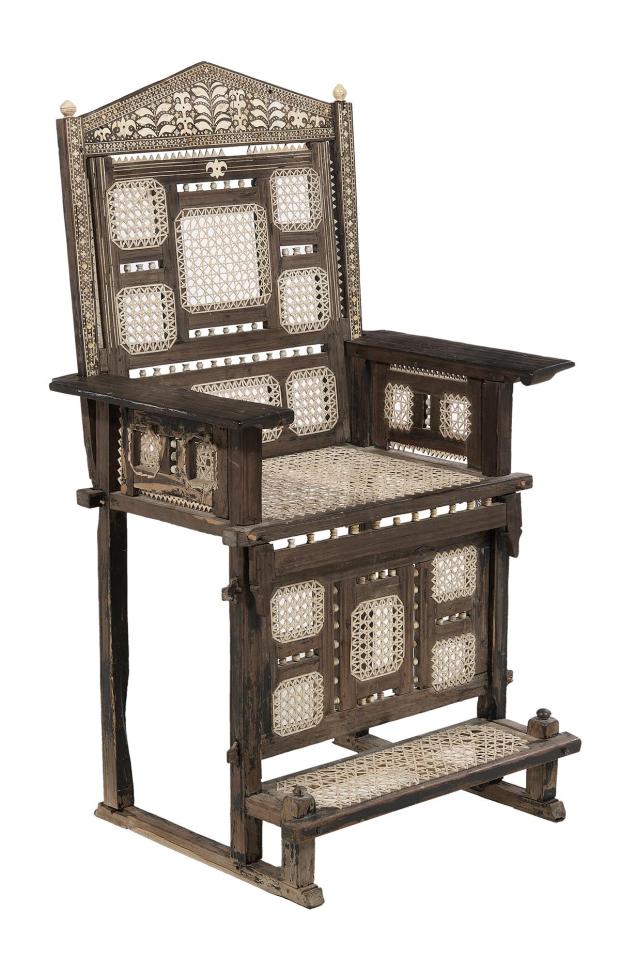
the kiti cha enzi (swahili for "chair of power") style of chair reflects both the tradition of decorative chairs being associated with wealth and power in many niger-congo language-speaking societies, as well as the various artistic influences which converged on the swahili coast due to trade. the chairs, only ever made in mombasa and the islands of pate, lamu, and zanzibar, are wooden - mostly ebony - with the seats made of woven string, and inlaid with ivory, bone, and sometimes silver.
the style was first developed in the 15th century. (this particular chair dates to the 19th.) despite the chairs' intricacy, they're also designed to be easy to take apart and carry - an important feature for past swahili rulers and other important figures who were always on the move. wealthy families tended to have at least four which they'd use to seat important guests while less wealthy families may have owned less decorative versions.
#swahili coast#items#my posts#site doesn't say where this was made so i tagged both. shrug#also i specify language because the like. importance of the chair itself is more pronounced#you'd be surprised at how much similarity language groups carry over despite geographic and historical distances#pretty much every greek/roman god has a hindu counterpart for example
2 notes
·
View notes
Note
Hi, sorry for the weird question but how is Coptic the original Egyptian language when it uses the Roman alphabet? I was also wondering doesn't that technically mean it's not an Egyptian language since it was taught through the roman invasions?
Okay so that’s a good question. It all started in the 3rd century BC when Egyptian priests started using Greek letters to write down medical spells for other Greeks since they could not read Egyptian correctly due to the non-existence of vowels in pre-coptic writing systems.
This Coptic (Greek) writing system started spreading more among Egyptians who converted to christianity due to the hellenization and Christianization processes in the country. Plus they started using it more than older Egyptian writing systems (hieroglyphs, demotic, etc..) since those writing systems have pre-christian pagan origins, but Koine greek was the language of the New Testament so it all adds up to why Egyptians started using Coptic instead of older systems of writing.
Now the question is, does that mean that coptic is Greek? The short answer is no. Otherwise, we’d consider English a Roman language, or Russian a Greek one considering that its Cyrillic alphabet was also heavily influenced by Greek. Of course the same goes with other languages like Swahili, Xhosa, Zulu, Vietnamese, Farsi and Urdu, etc.. in which they collectively borrowed their letters from other languages.
This is such a huge topic but I tried giving you the important points briefly so you would understand how things ago, so thanks for asking ❤️
#coptic#egypt#kemet#ⲭⲏⲙⲓ#archeology#ancient egypt#egyptian#egyptian mythology#pharaonic art#pharaoh#ancient languages#hieroglyphics#kumat#africa#middle east#answered#q&a questions
11 notes
·
View notes